

for partying. Personnel from each division worked the scullery, as they were voluntold, serving on the mess deck for at least six months.
Did you ever wonder what was done with the food waste?
All food waste was ground up and sent overboard as fish food... hence, the grinder.
The mess deck served another purpose all together different than the afore mentioned...
throughout the mess deck you could find hammocks that functioned as overflow berthing. During the day personnel were not to be in their rack, or hammock, unless they were the late watches, or on the binnacle (sick or injured) list. I mentioned that they had socials... ice cream, from time to time. The ice cream parlor/soda fountain was
just like back home, choice of ice creams and toppings, and possibly a couple of varieties of sodas... for the floats of course. During my time on ships we didn't see ice cream very often, as it took up a lot valuable space for the rest of the provisions. This battleship, and probably
others, had the ability to make their ice cream as needed. I didn't take a picture of the machines that supplied milk, they were nothing like the ones you see at a buffet, they were large coffer-looking contraptions. My guess is that milk was stored in the containers that came from the dairy, then poured in the machine.



The mess deck also served as the ship's store. The sailor could get just about anything he liked, with the exception of alcohol. The store stocked all the rating badges that the ship was manned with. If the sailor was lousy at sewing on his new rank, they could take their uniforms to one of the three tailors onboard. The tailor shop
also offered
alterations, sewing of the rating badge and hash marks, and pressing and cleaning. Most of these services were free, and any monies collected, went to the welfare and recreation fund. Something else we never had on ship... cobblers. For you that are unfamiliar with cobblers, they repair shoes. One cobbler was
assigned to the ship. Most of his repairs were free, with the exception of
half soles, and rubber and leather heels. In the Navy of my day, sailors were provided an allowance to purchase new shoes, but some rates (jobs) could get their shoes replaced through the supply system, I happened to be in one of those rates, working on the flight deck.
You couldn't go into war looking shaggy, so the Navy stationed barbers onboard ships. In the case of the battleship, four chairs,
minimal wait. You could get your hair cut in any style you liked... as long as it was the Navy's required style.
As you might be able to tell by now... a ship was a little city... in a big sea. The crew were not totally isolated from the world though, they did receive mail periodically. All ships had a post office, and the ship had its own address.
This little opening was a sailors access to home. Each time the ship hit a port, the sailor was hoping to hear from his family.
During my days, the ship would hit port, and there was a working party to carry the mail bags onboard.
On my first ship I remember working alongside our postal clerk, because we were in the same division, emptying bags and sorting as quickly as possible. The mail petty officers for each division were standing outside the window for mail. It was always a clamor to be the first mail petty officer to pick up mail. The reason I assisted with the mail... I ran the TV station... and programming material was part of the mail. In the early days TV programming came in cases that were 10"x10"x10", weighing about 20 pounds each, and always at least seven cases per week of programming; sometimes I would receive multiple weeks of programming because of our schedule. Then there was returning my old cases, which could be several weeks worth. Mail was an important morale booster in the day.
What would a ship be without stinky sailors... a clean smelling ship.
Imagine sharing you bathroom with 142 other guys. If you require privacy to take care of business, you would have needed to learn real fast how to focus on your task at hand, especially when it came to #2. Privacy... not.
You'll probably notice the sleek design of the toilets. By the time I made it to ships, they had stall doors, and regular toilets. Generally the busiest times were in the morning after reveille, and before taps.
You may remember me talking about not being able to visit one's rack during the day, with a few exceptions... here's why. Usually about 0600 (6:00 am) sailors would hear
HEAVE OUT AND TRICE UP at reveille. That meant, get out of bed, make it, and stow it away.
There are six racks in that oval, they would be easier to see if the mattresses were on them. The mattress was no more than a four inch piece of dense foam, with a mattress cover. Looky below.
The reason for tricing up racks, it allowed the compartment cleaner the opportunity to clean the compartment thoroughly, which included the head (bathroom) as well. Sailors within their specific division were voluntold for these duties, usually lasting six months too.
Battleships had a lot of personnel to keep it operating, and part of that was keeping things laundered. These bigger ships had more in the way of dealing with bed linens, mess linens, and uniforms. Not everyone
was fortunate enough to have pressed clothes. Here the services were applied to officer's uniforms, sick bay bed linen, Officer's Mess linen (tablecloths and napkins), Chief Petty Officer's Mess linen (tablecloths and napkins), Barbers' shirts, Cooks', Mess Cooks' and Bakers' uniforms, hats and aprons, Marine detachment khakis, and Steward's Mates' uniforms. If you were in one of these categories, pressing service was available, but not free. The charge was included in a monthly "finished service" fee that officers, chief petty officers, mess cooks, bakers, and galley cooks paid.
Now if you knew someone that knew someone, you might be able to trade services, and have a guy in laundry press your uniforms. For the less fortunate there two other options... put your uniform under your mattress and sleep on it, or create a makeshift ironing board and iron away. Laundry was part of a rate, but was sometimes
augmented by a personnel from other divisions. Laundry was a 24 hour service offered to the ship's crew. The men working in the laundry worked in two man teams, in 12 hour shifts.
For those that may never have been stationed on a ship, let me provide a little insight. In the berthing compartment laundry was sorted by blues and whites, this done in a laundry locker where two canvas bags hung, one for blues, one for whites. That guy cleaning the berthing, was the guy that dragged multiple canvas bags down to laundry, and dragged it back up.
I know you ladies might have some problems with the drying process on ships, it was very much like the way clothes were dried on the farm. You guessed it, laundry was washed, and sent back to each division for the sailors to find a way to dry it... this applied to first class petty officers and below... chiefs and officers had there clothes dried.
A memory from a North Carolina sailor. "We used to hang our dungarees over the side to bleach and soften them. We also worked a deal with the laundry guys to starch and press our shirts. This worked out pretty good until some of the officers complained we were looking better than they were, so we had to buy an iron and do it ourselves." Harold Smith, Fire Controlman 1/c.
Back in the day of this battleships, there weren't computers and printers, so the ship was equipped with a print shop.
The shop was responsible for: ship's newspaper, menus, Plan of the Day (schedule of events for the day), letterhead, liberty cards, ship's newsletters, maps, and plans for attack.
All that paper that was generated... what happens to it when it is not needed any more. Like all garbage went to the grinder, all paper products went to the incinerator.
Paper products were separated into either paper or cardboard. There was usually one person working the incinerator room; during general quarters the incinerator continued to burn. When they were ready to dispose of the ashes... soaked in water, they went over the fantail, in the wake of the ship.
I told you earlier that a ship is a city to itself when at sea. When something breaks, it is up the machine shop to fix it, or build it.
In a machine shop one could find milling machines, drill presses, lathes, and other assorted machinery needed to repair or replicate parts.
During my time in the Navy I had the opportunity to work with the MRs (Machinery Repairmen). They let me do some of the small non-critical parts, but most of the time I would engrave name tags and placards.
Staying with the "little city". If there is a fire or flooding, it's up to the ship's crew to handle it.
The wood stored here was used to shore up leaks in the hull, or sections of the ship that were collapsed. When shoring up, the wood needs to be cut to size... using hand saws. Before installing the wood braces, sand was laid on deck to prevent the wood
from slipping. On the battleship they used the mechanism on the left for counter flooding. The ship has 63 voids that can be flooded with 40 to 60 tons of seawater... in six minutes. The system on the North Carolina was put to the test September 15, 1942, when they were torpedoed. The last photo is a Damage Control (DC) Locker. There are multiple DC lockers on a ship, not knowing where damage can occur; the lockers have areas of responsibility. From the DC locker, damage is documented, information passed to Damage Control Central and the bridge, and where personnel are sent from to conduct repairs, whether fire, flood, or biological/chemical attack.
Let's get back to creating damage, its more fun.
What you are looking at is part of the process for sending rather large shells 23 miles away. Looking at the second photo, you can see the tips of blue shells, they are training rounds. The yellow and green are the ones that are lethal. For those rounds to hit their target you need powder. The "cut out" operator in photo four is responsible for getting product to the desired locations. The last photo is one of the powder elevators. The powder handling was pretty interesting too... are you ready.




The cannisters you are looking at contain three of the powder bags you see on the loading tray. This process was well orchestrated.
It moves from the magazine side to the elevator side, where another person begins the bag's trip to the barrel. The operator on one side, in the magazine, turns a knob and the operator on the other side of the powder shuttle, sees the same command.
This is the elevator that powder and shells travel up to get to the guns. This trip travels about five decks, helping the guys in the upper turrets to fire shells at that 30 seconds per round pace.
Here is an example of times changing. The first North Carolina would have fired something like the projectile on the left. As time moved on the projectile got bigger, and
required a bit more powder. By WWII the projectiles were weighing much more, needing even more bags. WWII projectiles required six bags of powder. It was interesting to learn about the bags and powder too. The bags were made of silk, because silk is strong, burned quickly, free of acids that could react with the gun powder, and left no residue in the barrel which might cause premature detonation of the next round. The projectiles required two types of gun powder, smokeless and high explosive. The way it worked: smokeless powder forced the shell out of the barrel, and the high explosive powder is needed to ignite the smokeless powder... who knew.
The guns were much more fun thanks to the Gun Control Center, located in the bowels of the ship... and it was available for touring on our "regular people" tour. This setup was very
commanding with all the equipment in the space. The control center was responsible for:

This was an important piece of equipment, called a
Stable Vertical. It contains a gyroscope that monitors the roll (side to side) and pitch (up and down, forward to aft) of the ship. The information went to a piece of equipment called the
Rangekeeper. From the rangekeeper it made to the plotting room tables.



During general quarters this place would have been hoppin'. Imagine yourself at a wedding reception, everyone talking at once, and you're trying to order something to drink... at the top of your lungs... multiply that about three times. The amazing thing that happens in that kind of situation, each person learns to hear the information that applies to them.
With this kind of excitement, there is sure to be casualties. All ships had some form of medical team on them. The bigger ships, like battleships, had a surgical suite.
With any hospital surgical suites there is a scrub room to go with it, no different for the North Carolina.
For day to day medicine, there was sick call, and the opportunity to get medication at the pharmacy.
The pharmacy wasn't anything you are use to today, they made their medications.
Bigger ships also have the opportunity for dental services.
The dental office has three chairs, and handled everything from routine care to oral surgery. You required an appointment to see the dentist.
Here is another crew members memory: "The ship's dentist pulled all four of my wisdom teeth same day. I had no pain. For thanks, and since I was a butcher, I made him a beef steak sandwich. The steak was tenderloin... no better meat than that". Lincoln Hector, Ship's Cook 1/c.
This was a fun experience, and there is so much more to see on the ship. As always, I encourage you to visit their site, or even come see the ship in person.









































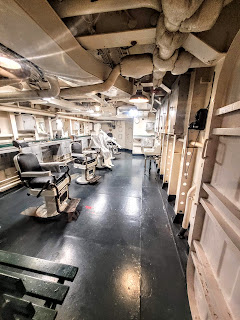
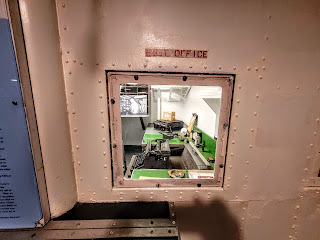










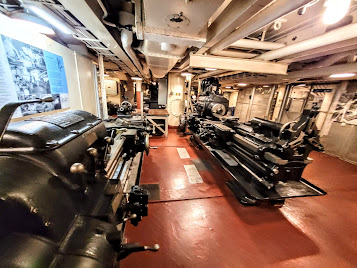



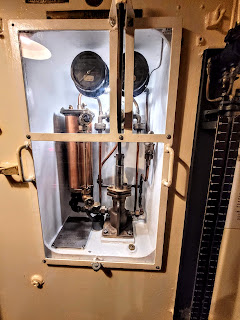













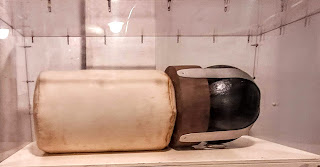




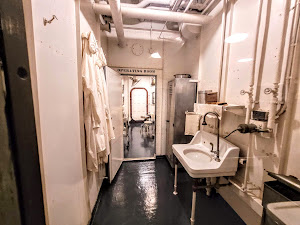





No comments:
Post a Comment